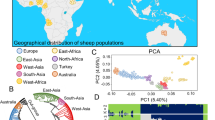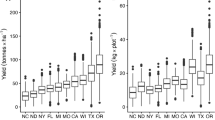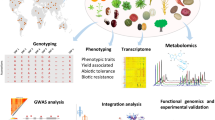Abstract
The estimation of the contribution of an individual quantitative trait locus (QTL) to the variance of a quantitative trait is considered in the framework of an analysis of variance (ANOVA). ANOVA mean squares expectations which are appropriate to the specific case of QTL mapping experiments are derived. These expectations allow the specificities associated with the limited number of genotypes at a given locus to be taken into account. Discrepancies with classical expectations are particularly important for two-class experiments (backcross, recombinant inbred lines, doubled haploid populations) and F2 populations. The result allows us firstly to reconsider the power of experiments (i.e. the probability of detecting a QTL with a given contribution to the variance of the trait). It illustrates that the use of classical formulae for mean squares expectations leads to a strong underestimation of the power of the experiments. Secondly, from the observed mean squares it is possible to estimate directly the variance associated with a locus and the fraction of the total variance associated to this locus (r 2 l ). When compared to other methods, the values estimated using this method are unbiased. Considering unbiased estimators increases in importance when (1) the experimental size is limited; (2) the number of genotypes at the locus of interest is large; and (3) the fraction of the variation associated with this locus is small. Finally, specific mean squares expectations allows us to propose a simple analytical method by which to estimate the confidence interval of r 2 l . This point is particularly important since results indicate that 95% confidence intervals for r 2 l can be rather wide:2–23% for a 10% estimate and 8–34% for a 20% estimate if 100 individuals are considered.
Similar content being viewed by others
References
Asins MJ, Carbonell EA (1988) Detection of linkage between restriction fragment length polymorphisms and quantitative traits. Theor Appl Genet 76:623–626
Beckmann JS, Soller M (1983) Restriction fragment length polymorphism in varietal identification and genetic improvement: methodologies, mapping and costs. Theor Appl Genet 67:35–43
Burr B, Evola SV, Burr FA, Beckmann JS (1983) The application of restriction fragment length polymorphism to plant breeding. In: Setlow JK, Hollaender A (eds) Genetic engineering principle and methods, vol 5. Plenum Press, London pp 45–59
Cramer JS (1987) Mean and variance of R 2 in small and moderate samples. J Econometrics 35:253–266
Darvarsi A, Weinberg A, Minke V, Weller JI, Soller M (1993) Detecting marker-QTL linkage and estimating QTL gene effect and map location using a saturated genetic map. Genetics 134:943–951
Edwards MD, Stuber CW, Wendel JF (1987) Molecular marker-facilitated investigation of quantitative trait loci in maize. I. Numbers, distribution, and types of gene action. Genetics 116:113–125
Ellis THN (1986) Restriction fragment length polymorphism markers in relation to quantitative characters. Theor Appl Genet 72:1–2
Gallais A (1974) Covariance between arbitrary relatives with linkage and epistasis in the case of linkage disequilibrium. Biometrics 30:429–446
Hill AP (1975) Quantitative linkage:a statistical procedure for its detection and estimation. Ann Hum Genet 38:439–449
Judge GG, Griffiths WE, Hill RC, Lütkepohl H, Lee TS (1985) The theory and practice of econometrics. Wiley, New York
Knapp SJ, Bridges WC (1990) Using molecular markers to estimate quantitative trait locus parameters: power and genetic variances for unreplicated and replicated progeny. Genetics 126:769–777
Knott SA (1994) Prediction of the power of detection of markerquantitative trait locus linkages using analysis of variance. Theor Appl Genet 89:318–322
Lande R, Thompson R (1990) Efficiency of marker assisted selection in the improvement of quantitative traits. Genetics 121:185–199
Lander ES, Botstein D (1989) Mapping Mendelian factors underlying quantitative traits using RFLP linkage maps. Genetics 121:185–199
O'Brien RG (1986) Power analysis for linear models. In:Proc 11th Annu SAS Users Group Conf. SAS, Cary, N.C. pp 915–922
Rebai A, Goffinet B (1993) Power of tests for QTL detection using replicated progenies derived from a diallel cross. Theor Appl Genet 86:1014–1022
Rodolphe F, Lefort M (1993) A multi-marker model for detecting chromosomal segments displaying QTL activity. Genetics 134:1277–1288
SAS (1988) SAS user's guide: statistics, version 6. SAS Institute, Cary, N.C.
Sax K (1923) The association of size differences with seed-coat pattern and pigmentation in Phaseolus vulgaris. Genetics 8:552–560
Scheffé H (1959) The analysis of variance. Wiley, New York
Schnell FW (1961) Some general formulations of linkage effects in inbreeding. Genetics 46:947–957
Simpson SP (1989) Detection of linkage between quantitative trait loci and restriction length polymorphisms using inbred lines. Theor Appl Genet 77:815–819
Simpson SP (1992) Correction: detection of linkage between quantitative trait loci and restriction length polymorphism using inbred lines. Theor Appl Genet 85:110–111
Soller M, Beckmann JS (1990) Marker-based mapping of quantitative trait loci using replicated progenies. Theor Appl Genet 80:205–208
Soller M, Genizi A (1978) The efficiency of experimental designs for the detection of linkage between a marker locus and a locus affecting a quantitative trait in segregating populations. Biometrics 34:47–55
Soller M, Genizi A, Brody T (1976) On the power of experimental designs for the detection of linkage between marker loci and quantitative loci in crosses between inbred lines. Theor Appl Genet 47:35–59
Theil H (1971) Principles of econometrics. Wiley, N.Y.
Weller JI (1986) Maximum likelihood techniques for the mapping and analysis of quantitative trait loci with the aid of genetic markers. Biometrics 42:627–640
Weller JI, Kashi Y, Soller M (1990) Power of daughter and granddaughter designs for determining linkage between marker loci and quantitative trait loci in dairy cattle. J Dairy Sci 73:2525–2537
Author information
Authors and Affiliations
Additional information
Communicated by J. Beckmann
Rights and permissions
About this article
Cite this article
Charcosset, A., Gallais, A. Estimation of the contribution of quantitative trait loci (QTL) to the variance of a quantitative trait by means of genetic markers. Theoret. Appl. Genetics 93, 1193–1201 (1996). https://doi.org/10.1007/BF00223450
Received:
Accepted:
Issue Date:
DOI: https://doi.org/10.1007/BF00223450




